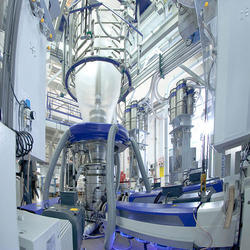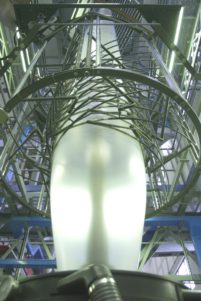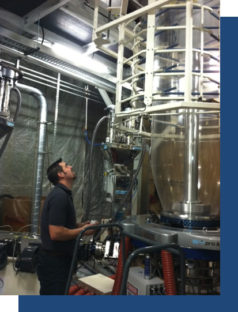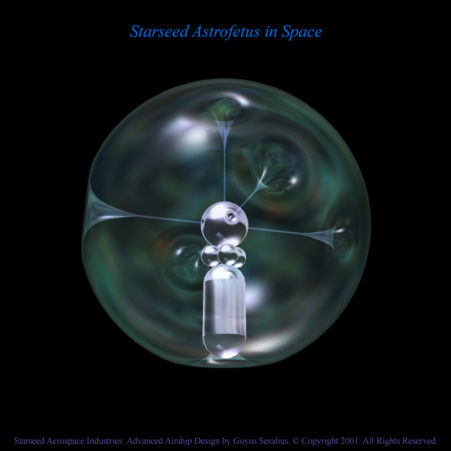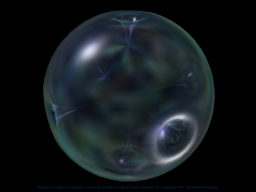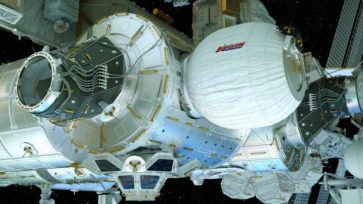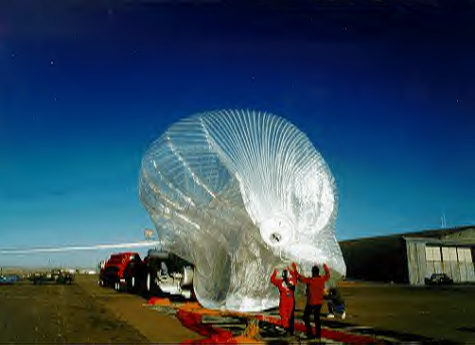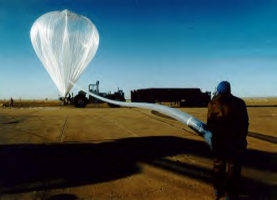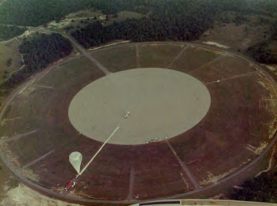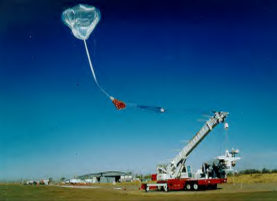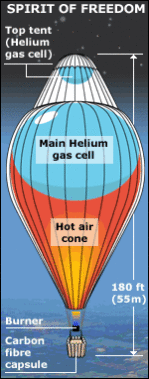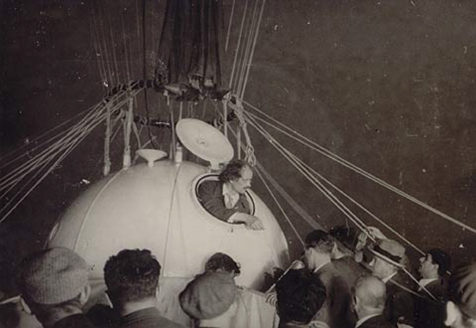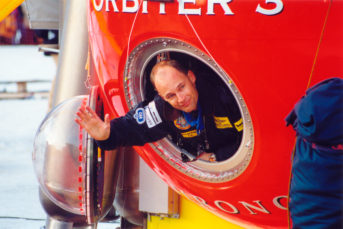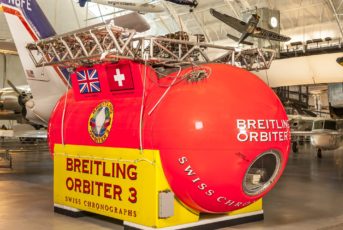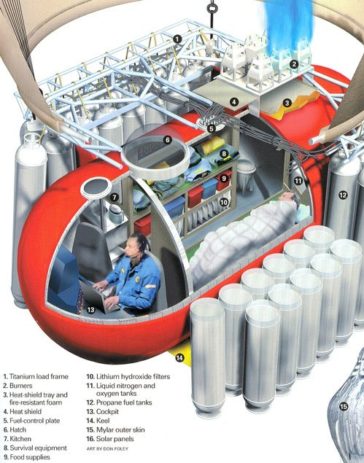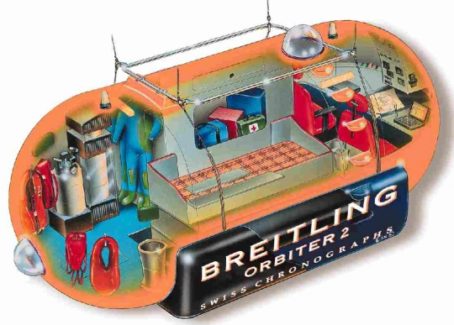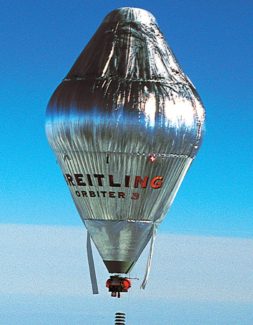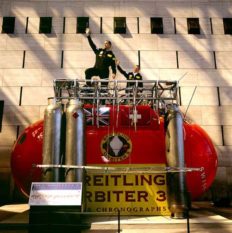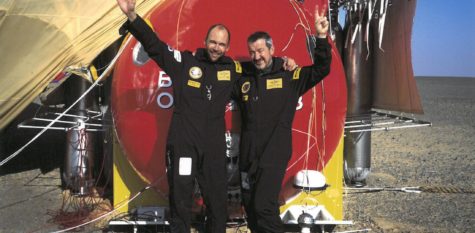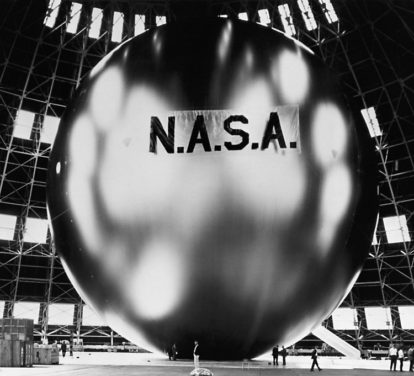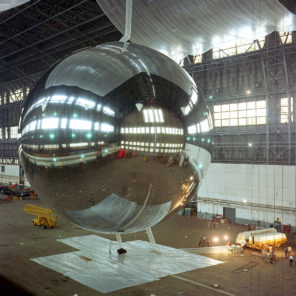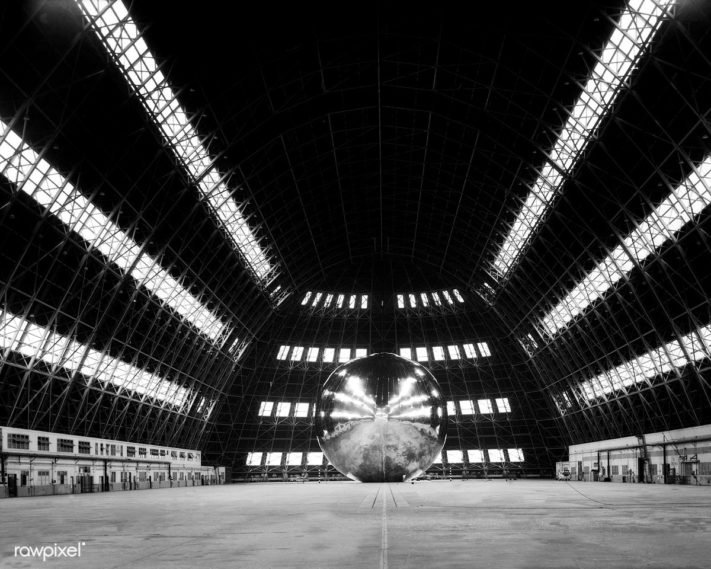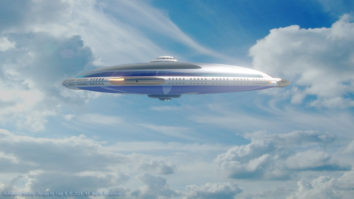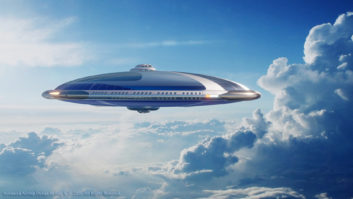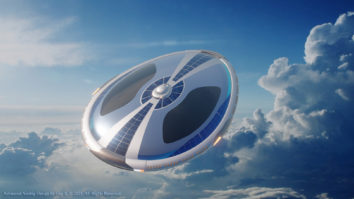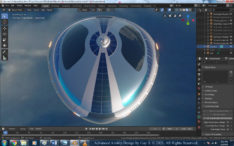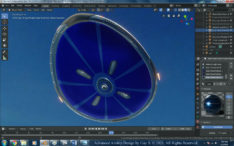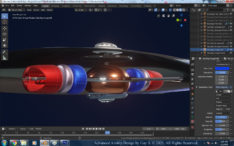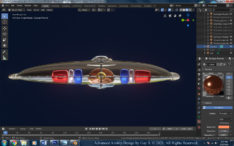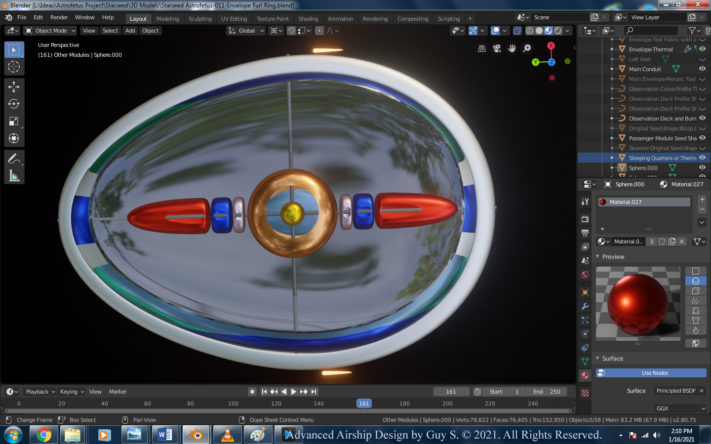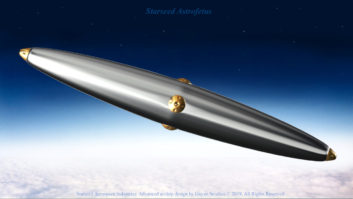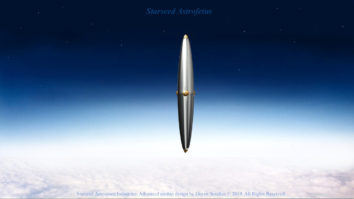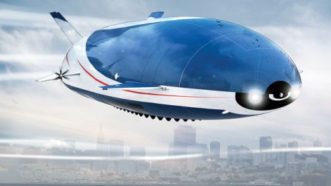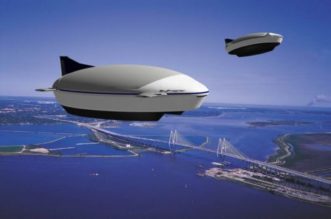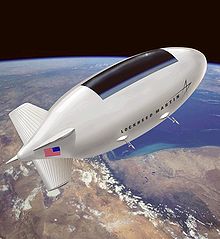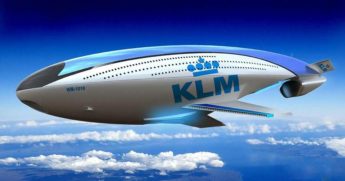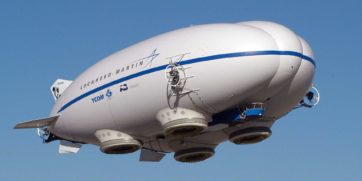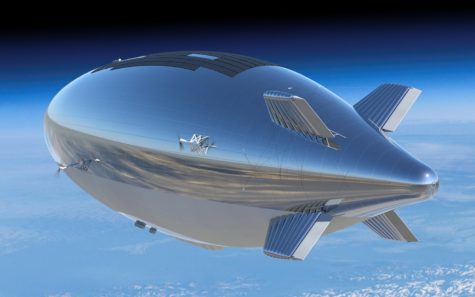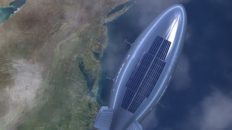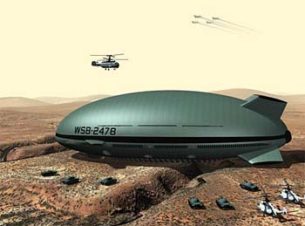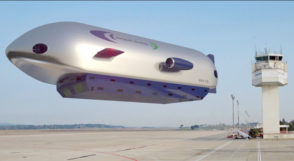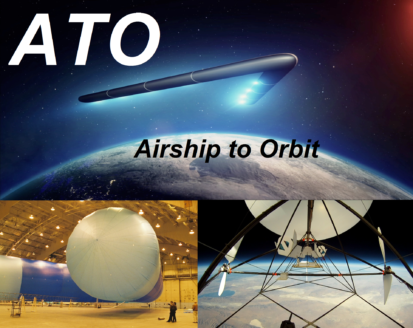
Ever since I was a young boy, I’ve had a fascination with balloons and airships. I used to wonder how high could a balloon go. Could one ever reach space, orbit the Earth, or travel to the Moon? Could an airship travel faster than sound at higher altitudes where the air is much thinner as spaceships usually do? Could an airship withstand the heat of the Sun’s powerful rays? All these questions gnawed at me and beckoned me to pursue their answers. I thought about these things, off-and-on, in passing, especially while daydreaming in class as early as my elementary school days. But as I got older and after I graduated high school, I became quite obsessed with balloons, both hot air and gas filled, along with other lighter-than-air airships like those huge, epic, rigid, dirigibles built and flown by Germans during the 1920’s and 30’s. So I became totally fascinated by the giant airships, such as the hydrogen filled Graf Zeppelin and the ill-fated Hindenburg as well the American built dirigibles like the helium filled Akron, Macon, and the Shenandoah, including non-rigid Goodyear blimps of the 1950’s on up to present day.
I also had developed a deep interest in rocketry, the Apollo space program, and space travel in general. These interests have allowed me to imagine traveling to the edge of space, to the Moon, and possibly beyond to other planets and to the stars in a very high-tech LTA airship. I have seriously fantasized about designing and constructing these futuristic, space-venturing airships for the last 24 years. In the following paragraphs, I will briefly explain how I think it can be done.

A Lighter-Than-Air Approach
To me, even at an early age, it seemed like using lighter-than-air technology would be so much cheaper and so much safer than using rocketry to reach space, which is so violent, loud, and terrifying. Based on the astronauts’ own testimonials, the launches were like shake, rattle, and roll. Apollo astronaut Frank Borman once said in an interview that “It was so noisy I could hardly hear myself think.” And Command Module Pilot Ken Mattingly once expressed that “It feels just like it sounds.” A rocket is much like a bomb wanting to go off. But I have to admit, putting aside the extreme dangers of using rockets, it is amazing to watch them launch like a skyscraper slowly climbing into the heavens on top of a controlled explosion as though it comes right out of the pages of ancient Greek mythology.
But a balloon-like system would surely be far more gentle and far more graceful, the way space travel was so eloquently depicted in Stanley Kubrick’s 2001: A Space Odyssey, where all spacecraft movement was like a peaceful ballet or waltz in a cosmic dance. To use an analogy of mine, ballooning to space is equivalent to classical music like that of Beethoven, whereas rocketing to space is more like rock and roll or heavy metal music. Both have their appeal, but in terms of my own personality, I prefer a more gentle, more graceful, slower approach to space.
Innovative Ideas—Old and New
Before I even knew how airships worked or what they looked like on the inside, I tried to design my own to possibly improve their functionality, capabilities, and safety. For example, I conceived the idea of using multiple smaller envelopes or gas cells (balloons) inside the main envelope and even smaller gas cells within those sub-envelopes. That way, if one ever leaked or tore open or popped there would still be sufficient lift to make a safe landing and the airship wouldn’t plummet to the ground like a rock. But then I quickly learned, after watching several documentaries on television and reading up on the subject from books I had checked out from the public library (this was pre-Internet days) that the German inventor of the rigid Zeppelin airships, Count Ferdinand von Zeppelin, had already come up with the same idea for the same reasons I explained and to help keep the ship level and in trim. He had a series of gas cell bags within the main envelope. But he never tried adding any additional inner envelopes within those secondary ones. Though, I suppose it really wasn’t necessary for his time and use.
I think one of the main reasons I was initially drawn towards airships as a possible vehicle to space is because of how most UFO’s where depicted in movies, such as in E.T., Close Encounters of The Third Kind, and Independence Day, along with any televised UFO documentary like those seen on Unsolved Mysteries or Chariots of the Gods. These recreations of these alien crafts usually looked and quietly hovered just like giant dirigible airships. So I continued to think about airships and how I might design and build my own, year-after-year.
Starseeds: Inflatables, Expandables, Blown, and Extruded
One of the winning key features of all my balloon/airship/spacecraft designs is that they would all largely self-construct by means of an inner core device that would extrude and ooze out their conduits and structural beams from molten polymers (most likely and usually polyethylene, along with a variety of fillers and binders) as well as slowly blow out their envelopes like bubbles in a soap dish instead of having to pay a lot of money hiring a huge team of people to spend enormous amounts of time carefully heat-binding or, in the case of woven fabrics, sewing together the large envelopes, piece-by-piece. To some degree, a device like this already exist and has been used for decades by manufacturers to extrude thermo polymer sheets and grocery bags. Of course those existing devices are very basic and limited compared to the ones I’ve been imagining. So essentially, using these more advanced extruding core devices, the craft would “blossom” out like a flower in full bloom—usually controlled by a computer program for intricate, elaborate designs. This could be done both on the ground, somewhat during launches, and certainly and most effectively in space where there is micro or zero gravity. I often call these inner core devices “starseeds,” since they would appear to grow all my space faring airships that look like fruit or blooming flowers. My crafts and space habitats would start out small but could quickly grow to become quite large in size. I’m currently in the process of patenting these ideas.
Inflatable-Expandable Habitats
I’ve also developed fully prefabricated, inflatable and/or expandable, concept designs. Several parts of the craft or habitat would be unfurled as it inflates into its full expanded form. Inflatable and expandable habitat designs have been proposed since the 1960’s and are still being worked on today by NASA as well as by private companies like Boeing, Bigelow Aerospace, Space-X, and others. Inflatables are a wonderful way to cut down on the costs of building habitats in space. In addition to inflatable crafts and habitats, I’ve worked on designs for inflatable heat shields to dramatically cut down on weight. Conventional heat shields cause spacecrafts to be ridiculously heavy, and the name of the space game is lighter is usually better and more cost effective. Weight is one of the worst enemies of a spacecraft designer. In fact, during the Apollo era, engineers essentially had to design and build a whole other module (the lunar module) to land on the Moon, because the command module with its heavy heat shield was just too heavy to practically achieve that. Also, in case of emergencies, I’ve designed inflatable landing gear that can be automatically deployed if the spacecraft detects its primary landing gear is not functioning or if the spacecraft is dangerously tilting or rolling over. They can be deployed manually, too, of course.
One of the biggest perceived disadvantages of using balloons (not the rubber kind) to reach high altitudes or space by researchers, aside from making and handling them, is the process of launching these monstrous sized envelopes. They often spend hours carefully unfurling each huge, thin, polyethylene envelope from a truck, have long polyethylene inflation tubes connected to its top to slowly inflate it very early in the morning when the wind is usually the most calm. Balloon researchers are always racing the clock to do this operation and are in constant fear the balloon will be prematurely lifted into the air by strong winds or that when the balloon finally does launch the wind will lift only the upper half of the envelop, since the entire envelope cannot be fully inflated at ground level due to current designs and inflation methods, and dangerously drag the manned gondola or scientific payload, damaging it or causing the death of an aeronaut.
I never really understood why they just didn’t construct a very sizable but very lightweight spool (made of lightweight materials like carbon fiber, thin aluminum, and pasteboard) that could be attached to the gondola. That way, they could unfurl just the amount of envelope to hold the needed volume of lifting gas that would more safely launch the balloon and payload, and then as it climbed higher and higher into a thinner atmosphere (causing the balloon to expand) more of the polyethylene envelope could be unfurled from its spool that was carried along. Anyway, I finally incorporated this envelope spool concept for certain designs that called for a more simple, mechanical unfurling of an airship’s envelopes.
Early on, I would design my airships so that many of the smaller inner envelopes were made either partly or entirely out of solar panel materials in order to generate electrical power for the ship and its operations, which meant my outer most envelope would remain somewhat transparent, so the Sun’s rays could reach those inner solar cells (I’m sure covering the entire outer envelope with solar panels would prove to be too heavy). In my latest designs, the outermost, thinnest envelope is a metallic looking, highly reflective, Mylor-type membrane, so as to prevent the Sun from heating up the inner gases. The temperature of the main lifting gas and all other onboard gases should be primarily controlled and managed by those flying the airship using internal lamps and heating coils and/or microwaves. So thin, lightweight, solar panels would be placed on the outer most envelope around the thruster bays (not covering the entire airship).
Surprisingly, I had never seen airships using solar panels. I thought it was such a waste not to take advantage of all that surface area, which was perfect for such a thing. The closest thing I had ever seen to it were those array of lights that are often draped over the outer membrane of a blimp to create low resolution text and image displays—mainly for advertising purposes. Most space crafts are always struggling to find any usable surface area to place solar panels on and so usually end up attaching them like flags or hanging them from wires on modern balloons and airships. But after a couple of decades went by, I finally started seeing airship concept designs where solar panels were being used in this way. This was another idea that I wondered whether or not was practical or realistic. Apparently, modern airship builders think it is, which helped me to feel validated once again. I would also like to incorporate hydrogen fuel cells to help generate electrical power during times when there isn’t adequate sunlight, such as during overcast days or at night, along with batteries in rare cases electrical power can’t be generated.
De Rozier Balloons

Another interesting idea I had, which I thought was brilliant, was to use a combination of both gas and hot air for added control. But then I came across a documentary on balloon history called, Lighter than Air: First to Fly, and learned it, too, had already been conceived of long ago. Only a few years after the invention of the hot air balloon by the Montgolfier brothers in 1783, a French physics teacher named Jean-François Pilâtre de Rozier, the first man to ever fly in a balloon, invented it and actually built and flew in one. In fact, this type of hybrid balloon was named after him, thus, being called a De Rozier balloon. I was painfully learning that these ideas that I excitedly envisioned had already been realized by others before me and had already been tried and tested. At least now I knew I wasn’t completely crazy or off my rocker. Tragically, though, Jean-François de Rozier naively used hydrogen, a flammable gas, in his hybrid design and sadly became the first man to die in a balloon when it exploded in mid-flight. The hydrogen apparently got too heated or was ignited by a spark from the fire underneath. This hybrid De Rozier type balloon design would later be used by 20th century aeronauts trying to circumnavigate the Earth, only this time no flammable hydrogen. They used helium instead. As far as I know, no one uses hydrogen in a hybrid design anymore. It’s viewed to be too dangerous. Even though helium is a little heavier, it’s not flammable at all and so totally safe in that regard.
Using Hydrogen as a Lifting Gas and a Propellant
This leads me to yet another fascinating idea I came up with many years ago but one which someone may have beaten me to, fair and square. He even managed to get the idea patented in the year 2000 (ironically, the very year I was doing US patent searches to see if others had similar airship concepts and designs as mine). The idea is to once again use hydrogen as a lifting gas (primarily for high altitude and space flight missions only) but to also us it as a propellant once the balloon or airship system is high enough in the atmosphere. It wouldn’t be any more dangerous than astronauts riding atop a rocket with hundreds of thousands of gallons of highly pressurized liquid hydrogen just below them as they’ve done in the past and continue to do right now. In fact, the use of gaseous hydrogen in a balloon/airship system would be far safer, since it isn’t being so highly pressurized into a cold liquid. The idea hit me when I first learned that rockets (both past and present) usually use hydrogen (the very same lifting gas used to fill the earliest balloons and the old German airships) as their propellant. I thought to myself, Instead of carrying enormous, heavy, liquid propellants and liquid oxidizers all the way to orbit, why not allow those chemicals to be in their more natural gaseous state which would then actually provide lift and not serve as a hindrance. It requires much thicker, heavier, stronger tanks and lots of additional hardware to cool down, pressurize, and condense those gases down to a cryogenically cold liquid, not to mention the process of cryogenics is very expensive and dangerous. And so it requires even more fuel to lift the heavier than air liquid fuel and all those heavy metal tanks used to compress and hold those liquid propellants and oxidizers.
As mentioned, during my college years, I was doing US Patent searches on airships and low and behold, someone had just recently patented that very idea for the very same reasons. This process of coming up with great ideas only to later learn someone beat me to it was somewhat maddening! I usually had mixed feelings about it. On one hand, I felt robbed as though I was having my good ideas stolen from me during the night, but on the other hand, I was learning that my ideas had merit and felt validated and happy for the progress that was clearly being made or might be made if engineers and designers started using them. The good news is that I still had a good number of ideas at that time as well as ideas I would later conceive that had not yet been discovered by others, at least not that I know of. I wish I could share them all, publicly, here and now, but I better keep many of them under my hat for now as trade secrets. However, I will continue to share a good number of them in this essay for all you fellow airship and space travel enthusiasts and just to get them off my chest or I may burst!
Space-Age Gondolas
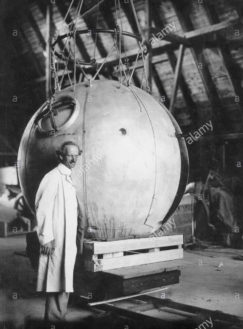
I also spent a lot of time trying to design a gondola that could be much better than some old wicker basket usually seen on gas and hot air balloons. I wanted something safer and more sophisticated and even capsule-like, a gondola that could be pressurized to go into the upper atmosphere or even space. But again, after reading books like The Pre-Astronauts and The Balloon Book and watching documentaries on The Discovery Channel and The Learning Channel like The Last Great Adventure: Around the world in 20 Days and Three Men and a Balloon, I learned that pressurized gondolas were used as far back as the 1930’s. I still remember the feeling I got when I first saw old black and white footage of Swiss physicist and explorer Auguste Piccard climbing into a metal spherical looking pod that could be made air-tight and pressurized. He and fellow aeronaut Paul Kipfer became the first men to reach the stratosphere and to see the curvature of the Earth.
I was even more amazed and a little jealous in 1999 when I saw his grandson Bertrand Piccard, along with English balloonist Brian Jones, fly for days in a luxurious, hi-tech-looking, pressurized, carbon-composite gondola attached to his towering Mylar balloon called Breitling Orbiter 3 in a race to be the first to circumnavigate the globe in a free balloon (unsteered), which they did. Other contestants who had entered the balloon race had equally impressive gondolas or at least most of them did, such as the American adventurer Steve Fossett and Richard Branson of Virgin Airlines. I had never before seen such sophisticated looking gondolas! Inside the gondolas were impressive modern-day consoles with all sorts of high-tech equipment, dashboard gauges, valves, dials, switches, and knobs. They looked just like I had been envisioning for years.
Another team in this balloon race, known as team RE/MAX, had planned on ascending in a gas balloon to what some call the real edge of space and the ceiling of our atmosphere (around 130,000 ft) in what truly looked like a space-age capsule, so they could stay well above the hazardous weather down below as they attempted to circumnavigate the globe. In fact, the three men that were going to ride in it where going to have to wear actual space suits that were themselves pressurized. They ended up calling it all off—I forget why—but it showed me there were others who were thinking along the same lines.
The X-Prize: A New Space Race
Around this time, during the turn of the millennium, I had the pleasure and, once again, the jealousy of watching different teams who had joined a new space race in an attempt to design and launch their own spacecrafts into Earth orbit in hopes of winning the recently announced X-Prize (an idea I, myself, had after watching The Spirit of St. Louis, starring Jimmy Stuart, who played Charles Lindbergh, the first man to fly across the Atlantic Ocean after entering into a race involving a prize). I, too, thought it would be a good idea to offer a new modern prize to spark up and stimulate new interest in aviation, to try and break new records or to push beyond our technological limits in terms of airship designs and space exploration. So you can imagine my surprise and delight when I first heard about the X-Prize!
Rockoons

This next idea was such a no-brainer and one that was already conceived of many decades ago by Cmdr. Lee Lewis, Cmdr. G. Halvorson, S. F. Singer, and James A. Van Allen, and that is using a balloon system to serve as the first stage of a rocket system. In the 1950’s, these balloon-rockets were named “rockoons,” because a balloon would first carry a rocket and its payload to a high altitude, where the rocket would separate and ignite to finish its journey into the atmosphere or space. For some reason, the term ‘rockoon’ seems to be limited to just solid fuel rockets, but in my opinion should apply to any type of rocket (solid, liquid, or gas) lifted by a balloon.
I still can’t believe and don’t understand why rockoons are not being used today on a regular basis. They are so much more sensible, so much more cost saving, and so much safer to launch in this way. I would love to go back and research their history more to find out why they were abandoned. The only thing I can find that might explain why is because balloons aren’t steerable. Many of the sources I found discussing rockoons mentioned this problem. If so, the solution is simple; use steerable balloons! Steerable balloons, also referred to as dirigibles, are basically airships. With airships, there should be no more excuses not to use them in most cases. Perhaps rocket engineers and companies (both private and government operated) think that balloons can’t lift the more complex liquid rockets. But I’ve roughly estimated that after you remove their first stages and all the unnecessary outer structures used to help a rocket punch through a dense lower atmosphere, they can be light enough to lift above the troposphere or even higher to then ignite and launch into space. Maybe they think an airship for a first stage is just too silly. I predict we will definitely see a return of rockoons in the broad sense I explained above (not limited to solid fuel rockets). I’ve already come across some commercial and non-profit websites looking to use rockoons to help place satellites into orbit or to explore and study space vehicle concepts and space in general.
In the past, NASA has shown some interest in using balloons in space. I was shocked and amazed when I first learned that NASA had successfully used a Thor-Delta rocket in 1960 to launch a Mylar-type balloon, named Echo 1A, to an altitude of about 1000 miles high, well above the Kármán line of 100 km (62 miles) that defines the official beginning of space, where it then inflated to a diameter of 100 ft. It was a simplified satellite that served as a passive reflector for microwave communication signals. Believe it or not, it remained in Earth orbit for 8 years! Its orbit finally decayed in 1968. Oddly, this is the reverse of a traditional rockoon. It’s interesting to know, though, that a balloon can, indeed, survive the harsh conditions of space while travelling at astronomical velocities.
The Ship of Dreams
I’ve designed a wide range of LTA airships for a variety of uses and have devised several different modes or approaches to reaching Earth orbit and/or the Moon using these more advanced LTA systems of mine, incorporating original ideas and design concepts that are in the process of being patented. But for this article, I will describe only one main design and approach, while including slight possible variations, here and there.
To briefly describe one of my favorite airship designs, imagine a giant semi-rigid, dirigible, with large gas bag cells to provide most of its lift and one inner Mylar envelope to serve as a hot air chamber, making this balloon a hybrid gas and hot air balloon system about the size of the Hindenburg or a little bigger (roughly a 1000 ft long), though nowhere near as heavy, since it will not have all that endless inner metal scaffolding framework and other unnecessary hardware for a high altitude or space flight. As its lifting gas, it would primarily use helium and/or hydrogen, depending on the occasion, and could compress much of those gases back into their on-board storage tanks (in a gaseous state), so they don’t have to always be vented into the air and permanently lost to the surrounding atmosphere or space, especially when it comes to helium which is now so expensive and in limited supply. Other smaller gas bags would hold nitrogen, oxygen, and heated water vapor in the form of steam so as to help provide lift instead of adding weight.
The inner structure is a collection of semi-rigid conduits; one main vertical shaft that serves as the main supporting trunk or backbone of the craft upon which several things are attached to or hang from (it’s somewhat similar to a ship’s mast). The other conduits run perpendicular to each other; two along the z axis and two along the x axis. They help to provide structural stability, a kind of flexible scaffolding or framework. Some versions extend and retract in a telescopic way, much like an antenna does, while other versions expand and contract like a Buckminister Fuller structure or fashion. Some might be constructed out of lightweight high density polyethylene, carbon fiber, or may even be largely made of inflatable materials or a combination of these materials. They will never be made of any type of metal like the aluminum or duralumin girders and keels of the old classic dirigibles which would easily bend in storms and tear and help rip their ships apart like a giant can opener. Crewmen may climb up and down the vertical shaft by means of a lightweight ladder or a pulley assisted elevator that can be either manually lifted and lowered by pulling on nylon ropes or cables and/or by turning a cable wheel or by electric motors.
At or near the center of the ship, where all the conduits meet, there will by a gyroscopic device so the airship’s orientation can be determined, along with weighted wheels that can spin in any direction depending on how one wants to orient the ship. Beyond those mechanisms is a sizable Mylar envelope, roughly the size of a traditional hot air balloon, where regular air can be heated to provide added lift. On the outer side of this Mylar envelope are thin lightweight solar panels to collect the Sun’s rays in order to produce electricity to power the airship, or as mentioned before, on the very outer most Mylar-type envelope. Counterweights may be used to be automatically or manually positioned along a long cable or rod that runs along the ship’s length to help manage its trim, so as not to have to vent precious gas or to drop precious ballast.


This grand airship would carry a pressurized capsule-like gondola on the bottom as well as a smaller one on top that can serve as a kind of crow’s nest. Some ‘crown gondolas,’ as I sometimes call them, may even include a widow’s walk to allow passengers or aeronauts to walk out into the open air at lower altitudes. The gondolas themselves will almost always have bluish solar panel membranes along their outer hulls and aerospiked reaction-control-systems (RCS) or thrusters on their tops and sides with one large conical, toroidal, aerospike engine underneath. The same goes for the airship itself in terms of its thrusters. I wanted to pretty much do away with the concept of hinged rudders, elevators, ailerons, or traditional stabilizing fins. They’re too problematic for how I’m designing my airships. For most of its orientation control, it would use its RCS thrusters I already mentioned and inner gyro wheels (electrically spun in the desired direction) to direct its nose towards any direction during flight or while stationary. Gyro wheels have never been used quite like this before, so it is an experimental idea that may not be sufficient. I do plan to allow the airship to at times be reshaped, by the command of those operating the craft, so that it has stabilizers but not in the traditional sense as normally constructed for aircrafts. I’ll hold off on explaining the details of that, because it’s a bit unusual and would be difficult to adequately describe.

One of the most interesting features of this airship design is that it can change its shape by means of retracting or extending its long inner conduit limbs, which the envelops are attached to. Again, I don’t want to go into too much detail as to how I think I can achieve this morphing technology, so as to protect my ideas, but I will at least let you know it involves heating the thermoplastic envelopes, pressurizing or depressurizing the gas cells, and using cords, pulleys, spools, pumps, inflation tanks, compressors, etc. Being able to reshape an airship provides many great advantages. Certain shapes are ideal for certain altitudes but not so good for other altitudes. For example, a fat cigar shape works real well at low altitudes where the atmosphere is much thicker and where airships may at times get violently buffeted around by strong winds. At extremely high altitudes, an airship may need to be far more streamlined and aerodynamic to better pierce through the atmosphere if hoping to travel at very high speeds. So a much thinner narrower cigar shape would be better. A fully round or conical shape would be good if the craft needed to slow down its descent or use its outer envelope for aerobraking or to reduce its high point of an elliptical orbit. Last but not least, reshaping an airship’s outer envelope so that it becomes an overall lifting body would help it gain more lift.
Hopefully, inside the airship, there would be an ion drive and ramjet system, so that the airship could draw in surrounding air as well as channel the incoming air rushing into its leading aperture to ionize it and thrust it out one of its thruster outlets or main engine. One or more large lightweight propellers may be used within its inner conduits to help in its propulsion, whether the air is ionized or not. Placing the propellers so far inside the airship may give ample time to use lasers to scan for large incoming objects like birds accidentally flying in or debris that could damage the blades and cause it to break away explosively in which case the propellers would be shut off and slowed to a stop, automatically. It may be possible to completely do away with propellers—which I would prefer to eliminate moving parts—and simply use ionization.
This hypothetical airship, which currently lives only in my imagination, would possibly be named Helios, Astrofetus, Startseed, Daedalus, or Olympus. I would eventually like to use all those names, sooner or later, to name the different airships of varying sizes, within my imagined fleet. I will likely reserve the name of Olympus for one of the much larger airships not really meant to go as high or to orbit the Earth, due to its massive size and weight. The same goes for the name Daedalus, since he knew not to fly too high towards the Sun as the myth goes. The name Helios would be perfect for one of the airships that would actually orbit the Earth and would, indeed, appear to be like the Sun (using a gold-colored Mylar-type film to ‘reflect’ its name). And of course, Starseed should be reserved for one of the airships or gondolas that goes beyond Earth towards the Moon or Mars or even further out towards the stars. The same goes for Astrofetus, which is an altered Greek-sounding version of Starseed (astro + fetus = star + seed) my younger brother came up with. I thought it sounded very cool. Actually, I will likely generally refer to all my airships as starseeds—I already do—kind of like how all soft drinks are often called sodas or all facial tissue is generically called Kleanex.

Small, scaled down, versions of my airship and gondola designs should be placed in Earth orbit, unmanned, and sent to the Moon and its surface to test its systems and to serve as cameras that will later record the final manned lunar landing(s). One from the front and one from the side. And each full scale lunar lander would be equipped with at least 2 probe cameras that could dock and undock with it to travel along its side, even at great distances, possibly a mile or more, to record and document the entire journey from several angles. It should record while travelling at equal speeds as well as using its own RCS thrusters to slow itself down and-or speed itself up to capture relative motion.
EARTH AND LUNAR ORBIT RENDEZVOUS or ZERO GRAVITY ZONE RENDEZVOUS: My Mode to Earth Orbit and the Moon Using a Lighter-than-Air Airship System
The Launch

Here’s how the launch would likely happen in most cases. The airship would start out in the shape of a fat cigar, hovering horizontally within its huge assembly and storage hanger, while its tail or belly gondola was attached to a mobile mooring mast (airships are traditionally moored by their noses). It would then either be dallied outside the hanger passing through its huge colossal doors or the airship would remain put until the roof of the hanger was slid completely open. Then its nose section would release the ballast that is holding the airship in trim so that the airship now begins to slowly become vertical and pointed skyward in a launch position and allowing it to stand twice as tall as the Apollo Saturn V rockets. Although, a heavy inner counterweight may simply be moved into position instead of releasing ballast to achieve the same effect. After all has been double checked, the airship may be released to slowly and gently climb into the heavens. It may be possible and even advantageous to launch the airship in a traditional horizontal trim position. It may continue to ascend this way or pitch its nose up at times, even very steeply on occasion until it reaches the desired altitude where it could then become level.
As the airship climbs, the Sun’s rays will begin to heat up the helium within its main translucent, gossamer thin outer envelope, or in more advanced models, as described earlier, its outer envelope would be highly reflective, so the inner temperatures could be better managed. If the pilot needs to heat the inner lifting gas, he or she can choose to do so by using electric lamps and heating coils or even microwaves. Once the airship reaches about 60,000 feet into the atmosphere, placing it into the stratosphere, its crew can now begin to unfurl and expand its main envelope, more and more, increasing its volume and, therefore, its lift. This main airship could be thought of as the first stage much the way a rocket has a first stage. Only we would not throw away this stage to drop into the ocean or to be hurled deep into space never to be used again as past rocket boosters have done and usually still do. This first stage airship would ideally be reusable and thus used again and again. If necessary, the first stage airship could inflate an additional external polyethylene envelope to help it reach the desired altitude of 100,000 feet (20 miles) which is roughly above 99% of the Earth’s atmosphere. It’s an ascent that would likely take the airship about 2 to 3 hours.
Using the Ionisphere
It may even be possible to utilize the ionosphere to gain more lift and horizontal velocity—another wild idea of mine, which may or may not work. I’ll briefly explain. The stratosphere and mesosphere are subsets of the ionosphere, an atmosphere filled with charged particles (free electrons and protons) which can be found as low as 46 miles above the Earth. It is said to be electrically neutral, though I predict there are currents or large areas that may be dominantly positively or negatively charged. Either way, the airship could maybe use electromagnetic waves or electron emitters to further ionize the area so that it does favor one charge or another and then ionize the outer envelope to be the opposite charge, thus, causing an attractive force to help pull the airship in any given direction, including up to higher altitudes.
Achieving Earth Orbit
Once the airship has reached a very high altitude, where the air is so thin and where the mesosphere sometimes begins (depending on where on Earth you launch from), the propulsion system of this giant dirigible may be initiated to push it higher and to start gaining horizontal velocity to put it on a trajectory that would place it in low Earth orbit at an orbital speed around 17,500 miles-per-hour. Whether it be an ion drive, ramjet, solar sales, plasma thrusters, or good old fashioned chemical combustion engines, or any combination of these, it may now start to pierce higher into the thin atmosphere. Having the luxury to wait until the airship is at such high altitudes before initiating its propulsion system is another great advantage over rockets, which have to build huge expensive complexes to hold the rocket in place and to redirect its loud powerful exhaust, not to mention the dangers of possible explosions so close to the ground where people, animals, and buildings may be in harms way.
This airship approach to space is really a lot like a rocket launch only in very slow motion. So another notable advantage is that the pilots and crew would have ample time to make corrections and to find solutions to any problems that might arise during their launch and flight. The burn will take far longer than a traditional rocket method, but should be far safer and more pleasant and enjoyable—less violent, no shake, rattle, and roll. This whole process will likely take several hours, possibly even days, depending on the propulsion system and thrust, to slowly but surely gain orbital velocities and to spiral into higher orbits. Now that this enormous, gigantic, man-made leviathan of the skies is travelling at 17,500 miles-per-hour in Earth orbit, it will likely need to orbit the Earth several times to make sure all systems are still working well and all is still a go. This will also allow for any experiments or data to be collected.
Trans Lunar Injection (TLI)
The next phase in the mission is Trans Lunar Injection (TLI), whereby the giant-sized dirigible fires its thrusters again to reach escape velocity (25,000 miles per hour) to head towards the Moon. However, it will likely be best to use a second stage airship at this point, one that would be only about a 4th of the size and weight as the main airship. It would separate from the main airship like a giant whale giving birth in the ocean of the skies and then fire its own thrusters, carrying the spacecraft and/or payload towards the Moon. Once escape velocity has been achieved, the multi-module spacecraft can either separate from the quarter-sized second stage dirigible, which I will now start referring to as the mothership, to continue on a flight path or trajectory to the Moon, allowing the mothership to slow down its speed by means of a gentle thruster burn or its ion drive to remain in very high Earth orbit, so as not to have to fight against so much drag against the relatively thin atmosphere; or the mothership and the spacecraft can remain attached and travel together all the way to the Moon for the next few days until they nearly approach the zero gravity zone between the Earth and the Moon, where gravity is cancelled out, at which point the spacecraft would separate from the mothership to continue their journey towards the Moon, while the mothership now performs its gentle burn to slow down just enough to get within the ZGZ. The benefit in this approach, is to have the mothership so nearby in case anything goes wrong and to make their future rendezvous easier, not to mention to have the comforts and amenities the mothership can provide on the long return voyage back to Earth.
Lunar Orbit Insertion (LOI)
As the modular spacecraft, which consists of three modules; the Service Module, the Command Module, and the Lunar Module, approaches the Moon for Lunar Orbit Insertion, its Service Module burns its engine to safely enter the spacecraft into lunar orbit, using the larger service tanks, and remains in orbit for as long as needed. The Command Module also doubles as an emergency capsule during the entire mission if anything happens to the Lunar Module, which may normally be the primary living quarters and reentry vehicle when having to reenter Earth’s atmosphere without the airships.
Lunar Descent: Descending to the Lunar Surface
Now that the spacecraft is in lunar orbit, the Lunar Module undocks from the Command-Service Module (CSM) meant to later propel itself and the Lunar Module back out of lunar orbit for Trans Earth Injection (TEI), and fires its aerospike engine to begin its descent towards the lunar surface. The CSM remains in lunar orbit kind of like a watchful big brother, thus, a big brothership. So there’s the fathership, the huge first stage airship still in Earth orbit, the mothership parked in the Zero Gravity Zone, and the big brothership that will remain in lunar orbit awaiting little brother’s return. I may design the Lunar Module (LM) to leave behind its parachute and inflatable heat shield assembly as it undocks to save weight. It will then hopefully safely land on the surface of the Moon—taking another giant leap for mankind.
Lunar Ascent: Ascending back into Lunar Orbit
When the crew is ready to launch, it will fire its engine once again to achieve lunar orbit. Then it will dock with its big brother the CSM and reattach its parachute and heat shield assemblies. It will either fill up its own tanks or simply use the Service Module’s already semi-filled tanks to propel itself out of lunar orbit for TEI. Nothing gets thrown away or left behind. Although, on hopefully rare occasions, tanks can be detached and removed to save on weight.
Trans Earth Injection (TEI)
The Lunar Module and CSM dock, they may orbit the Moon a few times checking all systems again and making sure all is good to go, then fire the CSM engine to leave lunar orbit and to meet up or rendezvous with the mothership in the Zero Gravity Zone. After the mothership successfully reunites with the modular spacecraft, it performs a brief thruster burst to start allowing Earth’s gravity to take over and start pulling them back on a return course home. All along the way, the mothership (second stage airship) will be in full, expanded, spherical form like a puffer fish, reshaped by a command either automatically by an onboard computer program or manually by its pilots to act as a form of aerobraking to slow down their acceleration and velocity towards the Earth. As the mothership approaches Earth, it will burn to slow its velocity enough to get recaptured into Earth orbit. It will have to do a second burn a little later to make their orbit around Earth more circular. While orbiting the Earth, it should have ample time to check all systems again and to re-dock with the fathership, Helios.
Earth Re-Entry

Helios will now begin its reentry procedure and calm journey back to the surface of Earth by reshaping and expanding itself into a more spherical, puffer fish shape to aerobrake against the thin atmosphere and eventually by firing its thrusters (OMS burn-Orbital Maneuvering System). It will use its gaseous balloon system to return much the way it reached orbit, only in reverse, and will eventually steer its way back to the launch site from where it first ascended, so it can dock with its mooring mast and then be dallied back to its hanger.
If anything goes wrong with the ballooning system during these final stages and phases, the astronauts can use their Lunar Module capsule as a reentry vehicle, equipped with a thin lightweight hard-shell heat-shield and liquid nitrogen or methane as a coolant and ablative gas as well as an emergency inflatable heat-shield. After passing the heated plasma phase and communications blackout, it will inflate its 3 or 4 stabilizing balloons to slow down its rate of fall and to find equilibrium. If that system fails, then it will deploy its drogue shoots, and then its 3 main parachutes to drift down to the surface or sea, safely. If the main parachute system also fails, then the occupants can put on their own parachutes (a main and a reserve), climb out of the hatch and then hopefully open their own chutes to drift down to safety. Each will have a GPS tracking device, so they can be easily located, as well as a survival and first aid kit.
Well, I hope you enjoyed that fictional voyage to the Moon in a balloon!
To Sum Up
This LTA airship system is almost the opposite of the heavier-than-air-rocket method, which lifts all its propellant in cold, highly pressurized, heavy liquid form, and which is so much more violent, noisy, and dangerous, and more prone to malfunctions and errors. Instead, a dirigible system can actually gain lift from its propellants if using hydrogen and allowed to remain in its natural gaseous state. When needed, the hydrogen can be pumped into the combustion engines to be mixed with oxygen, and ignited for thrust. It can gently rise to a very high altitude during a 2 to 3 hour journey, allowing occupants to truly enjoy the view and the ride in a very peaceful, heavenly manner, and then slowly and gently gain orbital velocity. The extroverted, sensation seeking, mountain climbing type might actually prefer the more dangerous liquid rocket approach. But this airship system offers a more gentle alternative that I think will be more inviting to most who would like to travel into space. Personally, I would take the gentle balloon ride over the loud, violent, explosive rocket ride any day.
Update
Thankfully, I’m seeing evidence that more and more people are gaining a strong interest in balloon and airship technology again, such as private space and aeronautic companies like Lockheed Martin and World View and non-profit organizations like JP Aerospace, whose founder, John M. Powell, has been dreaming of airships to Earth orbit even longer than I have, from what I’ve read, and is making great progress. Powell’s approach is somewhat different from mine in that he is aiming to ascend much higher in a much larger, more buoyant, more delicate airship and a method that would involve a huge floating platform. But it’s all very interesting and conceptually sound in my view, so be sure to visit his website at http://www.jpaerospace.com to review his thoughts on the subject.
John Powell and other airship-to-space enthusiasts are interested in achieving the exact opposite extreme from the traditional, heavy, ground-based, liquid-filled rockets, striving to design and build crafts that are instead as light and as buoyant as practically possible to float to as high an altitude as realistically achievable before accelerating to orbital velocities. I’m hoping to take a balanced approach between those two extremes, to find the “middle way” as Buddhist would say, to seek that Goldilocks zone that’s not too low and not too high, so that my craft designs, though heavier than those by other designers intending to ascend to 200,000 feet or higher, may have more structural strength and stability. That’s the trade off as the law of compensation dictates (for every gain there’s a loss and for every loss there is a gain). I’m willing to trade off buoyancy in exchange for durability. I worry that trying to design airships that could buoyantly float far above the stratosphere would force my airship designs to be too large and fragile, making them as delicate as Chinese lanterns.
I used to want to design airships that could ascend to those higher altitudes, but after I calculated how huge they would have to be and how low in density, I started asking myself. Is it really necessary to ascend that high to achieve the goal of reaching Earth orbit? I finally concluded, probably not. Remember, the main reasons I wanted to pursue the whole airship to orbit approach in the first place was to get away from the complicated and hazardous launch methods of ground based rockets, to move away from the expensive launch towers, the cryogenic and pressurized fueling, to avoid the violent, dangerous rides upon rockets with their loud, terrifying, biblically large plumes of thrust, and to bypass fighting against the thicker, lower atmosphere. If my airships can just get high enough to avoid all that, before propelling itself towards orbital velocities, then I’m happy.
In my firm opinion, all three conceptual designs and/or approaches to reach space and Earth orbit (heavier-than-air liquid rockets, ultra lighter-than-air airships that ascend to amazingly high altitudes, or a balanced design and approach between those two extremes like I’m hoping to achieve) are all very doable and needed. Each has it’s pros and cons, its strengths and weaknesses, and its advantages and disadvantages. The recently designed and built airships by Lockheed Martin and other leading companies are very promising and far better looking than the old airships of yesteryears. It’s all very exciting to see the big airships making a return! I dream of starting my own aerospace company, someday. Currently, it exists in name only, Starseed Aerospace Industries. I would love to be the next Elon Musk or Jeff Bezos (space venturing CEO’s), only I would take a softer, slower, lighter approach and it would be in the form of a cooperative (co-op). Hopefully soon we can all balloon to the Moon!
My Book: Here you can review my book, The Forever All: A Philosophical and Spiritual Guide, and read several excerpts and chapters for free with the option of buying if you wish to read more. https://guyuseye.com/my-ebook
My Art: I will create custom art for you or paint or draw a portrait of you, your loved ones, or of your adorable pets using your own photo(s) for a good price. To view samples of my artwork, please visit my site https://www.guyusart.com
My Instagram site: https://www.instagram.com/guyusart
My Facebook Page, Panmeism: https://www.facebook.com/panmeism
My Facebook Page, The United Citizens of the World: https://www.facebook.com/TheUnitedCitizensoftheWorld.Guyus
